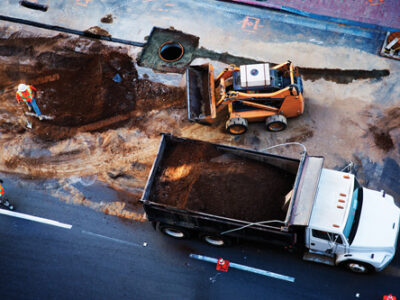Some California residents may feel sick at work but notice they feel better once they get home. Although some people may shrug off their symptoms, it is possible that the building they work in is contributing to their illness.
Sometimes, a building can make a person sick if they spend a lot of time there. According to the Environmental Protection Agency (EPA), contaminants within a building can cause illness in people. These might be biological contaminants, such as pollen and mold, or chemical contaminants. Mold and other hazards may develop on carpeting or ceiling tiles if water has amassed on these surfaces, and stagnant water can provide a breeding ground for viruses and bacteria. Windows and air intake vents, which are located near parking lots and building exhausts, may bring in outdoor pollutants. Additionally, people can become sick if a building is not properly ventilated.
If people spend too much time in a building with these hazards, they may develop Sick Building Syndrome (SBS). Healthline says that people may have a fever or headaches. They may also feel that their chest is tight and their skin is itchy. Sometimes people may think they have allergies because they are sneezing more often and have a runny nose. People can also experience neurological symptoms, such as forgetfulness or irritability.
Once people realize they have sick building syndrome, it is usually best for them to limit their exposure to these hazards. Some people might ask their employer if the air filters can be changed more frequently and if the floors can be vacuumed on a regular schedule. Other people feel better if they spend their breaks outdoors or walk around more often.
Expanding the Understanding of Sick Building Syndrome
While the EPA highlights biological contaminants like mold and pollen, SBS often results from a broader range of indoor air pollutants. These include volatile organic compounds (VOCs) released from carpets, office furniture, cleaning products, and adhesives; formaldehyde from insulation materials; and carbon monoxide from nearby traffic or poorly maintained equipment. Contaminants such as asbestos fibers and radon gas, if present, also pose long-term health risks.
Experts such as the National Institute for Occupational Safety and Health (NIOSH) and the American Society of Heating, Refrigerating, and Air-Conditioning Engineers (ASHRAE) have issued guidelines and standards for acceptable indoor air quality. Poor compliance with these standards increases the likelihood of SBS.
In California, many office buildings are sealed for energy efficiency, which often traps pollutants indoors. This creates conditions where irritants accumulate and recirculate through HVAC systems. A workplace designed to conserve energy may inadvertently compromise employee health if ventilation rates fall below the ASHRAE recommendations.
Symptoms and Their Broader Impact
Beyond headaches, itchy skin, or runny noses, SBS can lead to more severe or long-term health issues. Employees may develop chronic respiratory conditions, such as asthma or sinusitis, after long exposure. Neurological symptoms, including fatigue, reduced memory, and difficulty concentrating, may impact productivity.
This not only affects individuals. Employers experience economic consequences when indoor air quality is neglected. Increased absenteeism, higher health insurance claims, and reduced productivity are common outcomes of an unhealthy workplace environment.
Sick Building Syndrome vs. Building-Related Illness
It is important to distinguish between sick building syndrome (SBS) and building-related illness (BRI).
- SBS occurs when a cluster of symptoms improves after leaving the workplace environment, without a clear medical diagnosis.
- BRI refers to a medically diagnosable condition directly caused by building contaminants, such as Legionnaires’ disease or hypersensitivity pneumonitis.
This distinction is significant in California legal cases because SBS claims often rely on environmental testing and symptom documentation, whereas BRI cases can be supported by medical evidence. Courts and regulatory agencies treat the two differently, particularly when determining employer liability.
Employer Responsibilities in California
Employers in California have a legal duty under Cal/OSHA and federal OSHA regulations to provide workplaces that are free from recognized hazards. This includes maintaining safe indoor air quality. Their responsibilities include:
- Ensuring HVAC systems are properly designed, maintained, and inspected.
- Complying with ASHRAE ventilation standards and California indoor air quality regulations.
- Investigating employee complaints about poor air quality or SBS-related symptoms.
- Taking corrective action, such as mold remediation, ventilation upgrades, or regular filter replacements
Employers who neglect these responsibilities may face Cal/OSHA citations, workers’ compensation claims, or even personal injury lawsuits if employees suffer lasting harm. California courts have increasingly recognized indoor environmental hazards as valid grounds for legal claims, especially where negligence is evident.
What Employees Should Do If They Suspect SBS
Employees should not dismiss persistent symptoms as mere allergies; instead, they should consult a healthcare professional to determine the cause. Instead, they should:
- Document their health patterns: Keeping track of when symptoms appear and improve provides valuable evidence.
- Request testing: Indoor air quality assessments, mold inspections, and VOC monitoring can help identify the root cause of the issue.
- Seek a medical evaluation: Physicians can rule out unrelated conditions and provide medical documentation that links symptoms to the workplace.
- Report to Cal/OSHA if needed: If employers fail to respond, employees can file official complaints with Cal/OSHA.
- Consult with workplace attorneys: When exposure persists and damages are substantial, legal remedies may be warranted.
What Employers Can Do to Prevent Legal and Financial Risk
Employers should treat SBS not only as a health concern but as a compliance and liability issue. Steps include:
- Commissioning third-party indoor air quality audits.
- Scheduling regular HVAC maintenance and filter replacements.
- Use low-VOC cleaning products and furnishings.
- Offering employees transparency about testing results.
- Establishing workplace wellness policies that address environmental safety.
By being proactive, employers reduce the risk of lawsuits and improve employee productivity, retention, and overall satisfaction.
FAQs: Sick Building Syndrome and Workplace Rights in California
Does law recognize sick building syndrome in California?
Yes. While SBS is more challenging to diagnose than building-related illnesses, California courts and regulatory agencies recognize it as a workplace hazard when documented through environmental testing and symptom logs.
How long do symptoms of SBS last once exposure ends?
Many people experience relief within hours of leaving a contaminated environment, but prolonged exposure can lead to persistent respiratory or neurological conditions.
Can an employee be relocated if symptoms of SBS persist?
Yes, if remediation is not possible, some employees may request relocation or alternative work arrangements, especially if supported by medical documentation.
What should California employers do to avoid SBS lawsuits?
Employers should comply with ASHRAE standards, maintain HVAC systems, conduct regular air quality testing, and respond promptly to employee complaints.
What evidence helps prove that a workplace caused SBS?
Medical records, symptom logs, environmental test reports, and testimony from other affected employees strengthen a claim.
Take Action With Hussain & Gutierrez
If you suspect that your workplace is making you sick, you do not have to face the situation alone. At Hussain & Gutierrez, we represent California workers who suffer from unsafe workplace conditions, including poor indoor air quality and sick building syndrome. Our attorneys understand how to gather the right evidence, build a strong claim, and hold employers accountable under California law.
Contact us today to schedule a confidential consultation. Protecting workers across Los Angeles and California is our top priority, and we are committed to helping you pursue the justice and compensation you deserve.



